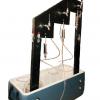Hello IFSQN,
I'm curious, are there any microbiological hazards of concern for roasted coffee? I am assuming that, because the green coffee undergoes the roasting process (where temps range from 390-430 degrees F), micros aren't likely to survive. Does anyone have a resource to back this up? I would like to be able to identify the specific microbiological risks in my HACCP Plan but I would also like to show that our roasting process is one of the several process controls in place. No in-house testing for microbe activity has been done however, so far I've picked up that roasted coffee is generally a low-risk commodity because: (1) at the production stage we roast the coffee at high temperatures where, for most foods, time and temperature control for most micro hazards are met and perhaps even exceeded; (2) by nature, coffee is a low water activity food where microbes are not likely to survive; (3) at the consumer level, the coffee undergoes brewing at high temperatures.
Any thoughts? Feedback?
Thank you!
















